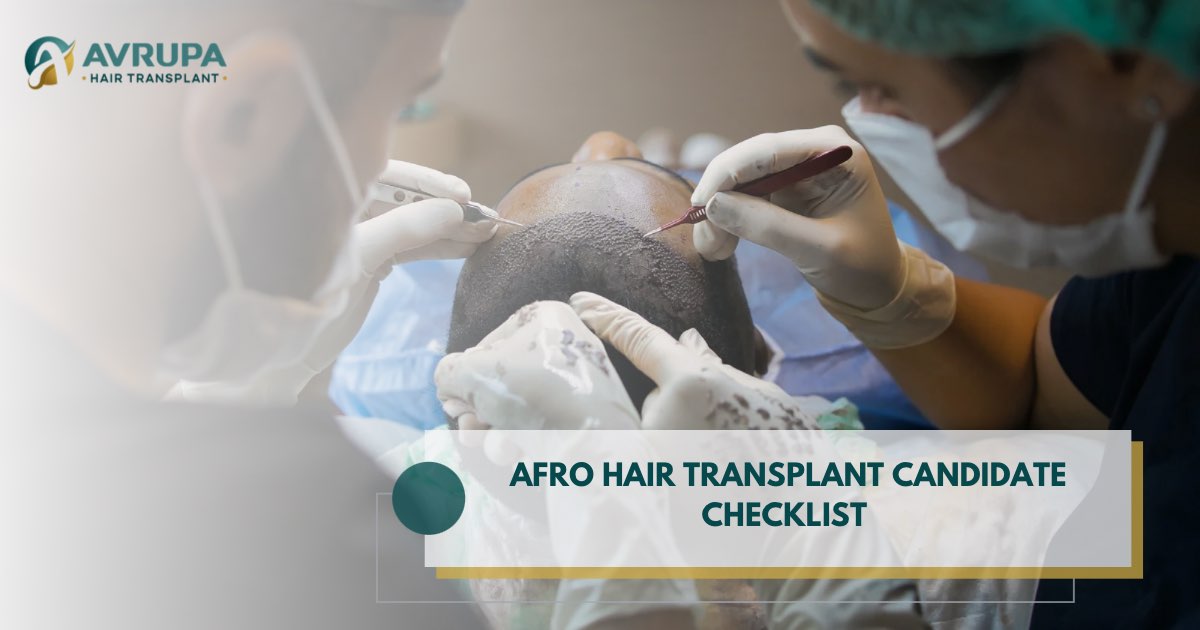
Afro Hair Transplant Candidacy Checklist

September 16, 2025 by
avrupahairtransplant
Not everyone with thinning edges or a maturing hairline is ready for surgery and not everyone who wants “3,000 grafts” actually needs them. For Afro-textured hair (Type 3–4), candidacy depends on three pillars: (1) correct diagnosis (ruling out active scarring disease), (2) donor math (what you can safely harvest without ruining the back and sides), and (3) optical density factors (curl, caliber, and color contrast) that often let Afro hair achieve great coverage with fewer grafts. This Afro hair transplant candidacy checklist turns those pillars into practical steps you (and your surgeon) can follow before you book anything.
Am I a Good Candidate for Afro Hair Transplant?
You’re a good candidate for an Afro hair transplant if:
- Your hair loss isn’t an active scarring alopecia (e.g., CCCA), and traction-related causes are under control. A biopsy might be needed when uncertain.
- Your donor density and follicular-unit quality support the needs of your hair transplant.
- Your goals match your optical density profile: curl + caliber often means fewer grafts for the same look compared with straight, fine hair.
What Determines Your Candidacy?
When considering an Afro hair transplant in Turkey some certain conditions must be ruled out before the physician gives you a green light. Consider the following:
Accurate Diagnosis:
A) Rule out scarring Alopecias—especially CCCA
CCCA typically starts at the crown and spreads outward. If untreated, it destroys follicles permanently. Dermatology references recommend clinical assessment and scalp biopsy when the picture is unclear. If the condition is active your physician will recommend delaying hair transplant until Alopecia is treated and becomes inactive.
B) Identify and stop traction
Tight braids, sew-ins, ponytails, weaves, glued frontals and heavy extensions can cause traction alopecia. First-line management is style modification; many early cases improve without surgery once tension stops.
C) Green light to consider surgery
- Loss pattern is stable (no inflammatory flares, photos steady).
- You can maintain low-tension habits after surgery (otherwise results won’t last).
Consider Your Hair Biology:
A) Native density differs by ethnicity
On average, African hair shows lower hairs/cm² than Caucasian hair in population studies (e.g., ≈190 ± 40 vs 227 ± 55 hairs/cm²). Curl and caliber in Afro hair create more shadow and bulk per graft, improving optical density even if the raw hairs/cm² are lower on average.
B) Optical density beats raw counts
Caliber (shaft thickness), curl pattern, and hair/skin color contrast drive how full a result looks at a given graft density. Professional guidance and reviews emphasize these variables when planning coverage; tighter curl and coarser shafts can deliver more “shadow” per graft.
Bottom line: Many Afro hairlines and frontal thirds reach natural-looking fullness at lower graft densities than straight, fine hair which is good news for donor conservation.
Donor Area Density:
A) Measure, don’t guess
Your surgeon should map follicular-unit (FU) density in the permanent zone, assess FU composition (1-hair vs 2–4-hair), and estimate a safe harvest fraction so the donor still looks natural at short lengths. Numbers vary widely person-to-person.
B) Respect the ceiling
Even with great donor density, per-session dense-packing beyond physiologic limits can reduce growth. Good clinics stage work rather than overshoot vascular supply in one pass. This is part of why “more grafts” are not always “better.”
C) Afro-FUE technique protects the bank
Curled follicles demand curvature-aware punches and controlled motion to lower transection. Peer-reviewed work shows curved or non-rotary/flared punches can cut transection dramatically in tightly curled hair.
Red Flags That Mean You Have to Wait
- Active inflammation, tenderness or spreading loss suggesting CCCA or another scarring process. If you have one of these conditions you must treat it first with a dermatologist.
- Ongoing traction you can’t realistically stop (tight installs, frequent retwists, heavy extensions). Change habits before undergoing a hair transplant.
- Keloid history with no prevention plan.
Ready to See If You’re a Candidate?
Candidacy isn’t about graft numbers; it’s about diagnosis, density, and a professional specialist who understands Afro hair biology. If you’re considering an African hair transplant Turkey, our team can guide you through every step, from assessment to long-term styling success.
FAQs
Why do some Afro patients need fewer grafts for the same look?
Because curl and caliber create more shadow and bulk per graft, improving optical density even if the raw hairs/cm² are lower on average.
Do I need a biopsy before Afro hair transplant?
If your doctor suspects scarring alopecia (e.g., CCCA) or the picture isn’t clear, a scalp biopsy helps confirm the diagnosis and decide timing.
Is FUE safer for Afro hair?
FUE usually avoids a long linear scar, but success depends on extraction technique adapted to coiled follicles; published studies show curvature-responsive punches markedly reduce transection.
Written By
avrupahairtransplant
Avrupa Hair Transplant Clinic, Istanbul’s trusted name since 2006, transforms hair restoration with cutting-edge techniques like FUE, DHI, and Sapphire, crafting natural, lasting results. With over 40,000 success stories and a collection of international awards, Avrupa blends innovation with artistry, delivering personalized care that redefines confidence for clients worldwide.